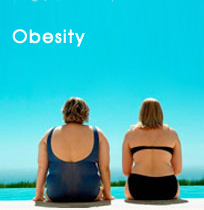| |
| |
 |
|
 Obesity is a major issue around the world, and as more and more people put on excess weight. Obesity is a major issue around the world, and as more and more people put on excess weight. It is a problem that is only likely to get worse. WHO has a serious concern on obesity and overweight because they pose a major risk for serious diet-related chronic diseases. The health consequences range from increased risk of premature death, to serious chronic conditions that reduce the overall quality of life. Overweight individuals experience depression, discrimination in educational, occupational, and medical setting and decreasing opportunities.
|
|
| |
|
Determining the Obesity
There are a of sophisticated methods for determining if someone’s weight is normal, or if they are overweight or obese, but there are three simple tools that are used to estimate if a person has weight problems. The tools that can be used are the BMI (Basic Metabolic Index), waistline and the waist to hip ratio. |
| |


| |
|
<18.0 |
Underweight |
|
23.0 – 24.9 |
Over |
|
30.0 – 39.9 |
Obese |
40.0 – 49.9 |
Morbid Obesity |
|
50.0 – 59.9 |
Super/Malignant Obesity |
|
60.0< |
Super Super Obesity |
|
 |
|
 Measuring your waist line is very simple in determining your health risk. Measuring your waist line is very simple in determining your health risk.
| |
|
Female |
Waistline is over 80 centimeters
(32 inches) |
|
Mail |
Waistline is over 90 centimeters
(36 inches) |
|
 |
|
|
| |
 |
| |
WHR = Waist / Hip
|
 |
If you are female and found that your BMI exceeds 30 and your waist-to-hip ratio is for example greater than 0.8, then you have proof that you are obese and that you urgently need to do something about your weight.
Determining the obesity through Height to Weight Ratio is not the right measurement. The result from Body Composition (with Fat Percentage) is the right indication in determining health risk. |
| |
 |
|
Obesity results from the excessive accumulation of fat that exceeds the body's skeletal and physical standards. The accumulation of excess fat leads to a health risk. |
|
 |
 |
| |

1. Gene
Many studies indicate that certain genetic factors are important and powerful underlying contributors to the development of obesity and binge eating.
Obesity is known to run in families and if you have one or more obese parents or grandparents then your chance of developing obesity is very great.
2. Too many calories
Consumption of more calories than are burned through work, exercise, and other activities will lead to overweight and obesity. The extra food was often some kinds of refined carbohydrate (white flour or sugar) combined with fat, saturated fat in the unhealthiest cases.
3.Modern Life
Too much foods but too little activity - a major factor leading to obesity is the ready availability in developed countries of inexpensive, tasty, food in combination with a sedentary lifestyle, including desk jobs and time spent watching TV, using a computer, and other "activities" that require little or no physical effort.
A recent study showed that housewives in the 1950s actually ate more calories than their modern counterparts - but they were significantly slimmer because their daily lives involved far more physical activity.
4. Medical problems
Some individuals are obese because of biological problems such as malfunctioning thyroid or pituitary glands. Some other medications also cause obesity or weight gaining eg. Contraception, Steroid pills or Diabetes pills. |
|
|
 |
 |

Obesity and overweight pose a major risk for serious diet-related chronic diseases, including type 2 diabetes, cardiovascular disease, hypertension and stroke, and certain forms of cancer. The health consequences range from increased risk of premature death, to serious chronic conditions that reduce the overall quality of life. Followings are the illnesses related to overweight and obesity :
1. Increased Health Risk of Type 2 Diabetes
Weight increase of 11-18 pounds raises a person's risk of developing type 2 diabetes to twice that of individuals who have not gained weight.
2. Increased Health Risk of High Blood Pressure
High blood pressure is twice as common in adults who are obese than in those who are at a healthy weight. Obesity is associated with high triglycerides and decreased HDL cholesterol.
3. Increased Health Risk of Heart Disease
The risk of heart attack, congestive heart failure, sudden cardiac death, angina or chest pain is increased in persons who are overweight or obese.
4. Increased Health Risk of Stroke
Atherosclerosis, or narrowing of the arteries, which may lead to the formation of an arterial blood clot, is an important pre-condition of many strokes. Atherosclerosis is accelerated by high blood pressure, high level of Triglyceride, smoking, high cholesterol and lack of exercise.
5. Increased Health Risk of Respiratory Problems and Sleep Disturbance
Obstructive sleep apnea (that is, interrupted breathing during sleeping for several seconds) is more common in obese persons. Obesity is associated with a higher prevalence of asthma and severe bronchitis, as well as obesity hypoventilation syndrome and respiratory insufficiency. It can also contribute to impaired job performance and automobile accidents.
6. Increased Health Risk of Arthritis
Musculoskeletal disorders, including osteoarthritis, are much more prevalent among obese patients, especially patients diagnosed with severe clinical or mobid obesity. Health studies show that obesity is a strong predictor for symptoms of osteoarthritis, especially in the knees.
An increase in body weight adds trauma to weight bearing joints and in middle age women's excess body weight is a major predictor of osteoarthritis of the knee. Weight reduction will markedly decrease the chance of developing osteoarthritis.
The risk of osteoarthritis increases with every 2-pound gain in weight.
7. Increased Health Risk of Endocrine Problems
Obese women are predisposed to get menstrual irregularities, other menstrual problems; and pregnancy complications especially toxemia and hypertension. Obesity impairs hormones and hormone imbalances of various kinds may contribute to, or be the result of, Obesity.
8. Increased Health Risk of Cancers
Obesity is associated with an increased risk for some types of cancer including endometrial (cancer of the lining of the uterus), colon, gall bladder, prostate, kidney, and post-menopausal breast cancer.
Women gaining more than 20 pounds from age 18 to midlife double their risk of post-menopausal breast cancer, compared to women whose weight remains stable. |
|





